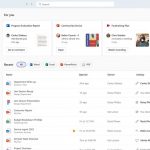At Zoomtopia yesterday, Zoom debuted a series of offerings, including Zoom Docs, AI-powered customer service tools, a beefed-up chatbot, and more hybrid work collaboration tools, despite its own recent attempts to send its employees back to their office desks.
Zoom Docs takes on Google Docs and Microsoft Word with traditional document creation capabilities, as well as wikis and drag-and-drop content blocks for tables, charts, and images. And it’s juiced up with AI to add content from Zoom Meetings, summarize content, search documents and more.
“As work continues to evolve and present new challenges, one thing will remain the same: effective collaboration and communication tools are crucial for businesses to succeed,” said Eric S. Yuan, chief executive officer, Zoom.
The company’s newly introduced chatbot, Zoom AI Companion, is getting Whiteboard capabilities, allowing customers to generate ideas on a digital whiteboard and organize them into categories, hence facilitating collaboration.
It might appear like Zoom is reinventing the wheel, especially after Google and Microsoft announced a litany of such AI-powered collaboration tools last month, with Duet and Copilot, respectively.
However, Yuan told Forbes that Zoom will stand out because of a “federated” approach allowing customers to work with third-party models and its own interchangeably, whichever is the cheapest.
Plus, Zoom says that its chatbot is included in its subscription plans, which start at US$149.90 per year per user. That, the company, says is “unlike other similar offerings that cost US$30 or more per user per month.” Microsoft, in fact, said it will charge US$30 extra per user for 365 Copilot, as did Google.
Other announcements from Zoom include access to employee engagement and communications solution Workvivo (acquired by Zoom earlier this year) from the Zoom Desktop Client, a new Wayfinding feature in Workspace Reservation to help employees find their desk or their reserved seating in unfamiliar spaces, as well as presence indicators and location information in the My Office View in Huddles, slated to be available in 2024.
Zoom Scheduler will also be getting new features, allowing customers to have more control over their calendars.
These features, the company says, are “purpose-built for hybrid, remote, and in-office work,” all while it tightens its own return-to-office policies.
The company is also plastering AI into a host of customer service tools including:
- AI Expert Assist, a generative AI that listens, adapts, and presents real-time outputs that help streamline contact center workflows.
- AI-composed event email invitations and lobby chats, available via generative AI in Zoom Events to better assist event managers.
Further, Zoom Virtual Agent and Zoom Contact Center will be integrated with Meta’s WhatsApp and Messenger.
The company’s stock opened at US$69.58 this morning, slightly lower than the previous day’s closing price of US$70.11. Analysts are expecting revenue growth following the decline in earnings growth over the past year.
Zoom hit an all-time high of US$568.34 in 2020.
Yuan told Forbes that “[Zoom] had the world during Covid, and now we start over to make Zoom better.”




